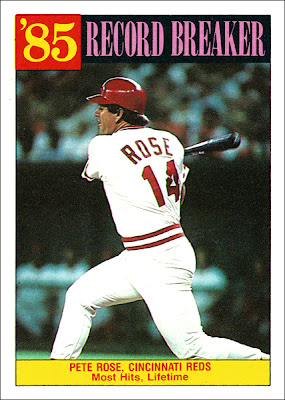THE SET
Vital Statistics
You know the drill: 792-card base set, 132-card Traded set.
A notable Dodger newcomer from this set is four-time batting champ Bill Madlock. Mad Dog was acquired for the stretch run in 1985 and hit a blistering .360 in 34 games for LA as they cruised to another NL West title. He stayed hot in the NLCS against the Cardinals, batting .333 with three homers and seven RBI. But he had to watch Jack Clark's backbreaking blast sail into the left field pavilion, taking a shot at riding his hot bat into the Fall Classic along with it. Madlock would have a decent year with the Dodgers in '86, but would get off to a bad start in '87, prompting his release and sending the revolving door at third base back into motion for the Blue Crew.
Special Cards
In 2013 Topps notoriously refused to use Pete Rose's name in its Chasing History blurbs on the backs of its cards. But 1986 Topps could rightfully be referred to as the "Pete Rose Set." We've already seen card #1 from this set, featuring the awesome 1B-MGR position designation. But that's just the beginning.
Managers
They're in the set again. Very good. But their cards are used as team checklists again. Not so good. Always glad to see them included though.
Record Breakers
Cards #201-207. The reason, of course, that Pete Rose is featured so prominently in this set is that he broke one of the game's most hallowed records, becoming baseball's all-time hits leader. At the other end of the spectrum, Topps recognized Keith Hernandez for breaking the record for a stat that had been in existence for just six years, and which would be abandoned by the end of the decade. But any excuse to use that great photo of him losing his batting helmet is worthwhile. Other cards in this subset include Dwight Gooden becoming the youngest 20-game winner and Phil Niekro becoming the oldest pitcher to throw a complete game shutout.
Pete Rose Special
Cards #2-7. Topps broke out a classic tribute, previously used only for Hank Aaron in the 1974 set in honor of his becoming the all-time home run king. Depicting all of his Topps cards over the years, from 1963, through the crew-cut years and the bowl-cut years, up until 1985, the Pete Rose Specials feature yearly career highlights on their flip sides. On the final card (#7), Charlie Hustle is shown honoring the memory of Ty Cobb, the man he supplanted as the hit king.
Checklists
These use the black frame along the card tops, with a yellow-backed checklist where the photo would be. A nice use of the set's motif, for what it's worth.
All-Stars
Cards #701-722. Other than the checklists, none of the subsets here uses the black border of the player/manager cards. That serves to set these cards apart, but none of the design concepts is very inspired. The All-Star cards are particularly spartan, but pleasantly so, with most featuring classic posed shots. The player names are bold along the top, but I wish the team name font would have been incorporated into the subset designs. The card backs are again used to display league leaders, which is not one of my favorite choices from this era.
Team Leaders
After a one-year hiatus, Team Leaders return, but in a completely different form. Whereas these had been used as team checklists from 1982-1984, the backs of these cards show the team's leaders in a number of batting and pitching categories. The cards, rather than showing batting average and ERA leaders for each team, depict the dean of each team, with the date from which their continuous service with the team began indicated on the back. The design, which was to persist in one form or another for several years, is one of my least favorite. The photo is turned into an amorphous blob, fading to oddly-shaped white borders, giving the impression that you're looking at a heavenly tribute to a deceased player. One of the few good-looking cards from this subset is big Lee Smith (#636), whose imposing presence manages to break through the fuzzy haze.
Turn Back the Clock
Cards #401-405. Reviving a concept first used in 1977, Topps gives us a little history lesson. These cards "Turn Back the Clock" in five-year increments, discussing the highlights of each season on the back. Unlike the '77 edition, these use Topps cards from the year in question as the graphic feature. Getting some baseball history is always a positive, but the thing that elevates this concept to something really special is that Topps stayed with it for the next four years, creating a multi-year subset that ends up covering 25 seasons.










Hey there!
ReplyDeleteQuick question:
Are cards #2,7 -- Rose and Hernandez record breakers -- the only "record breakers" in the set? If not, how many total record breakers were i the set? ThX!
J
Here's the Record Breaker checklist from 1986 Topps:
ReplyDelete201 Vince Coleman Record Breaker
202 Dwight Gooden Record Breaker
203 Keith Hernandez Record Breaker
204 Phil Niekro Record Breaker
205 Tony Perez Record Breaker
206 Pete Rose Record Breaker
207 Fernando Valenzuela Record Breaker